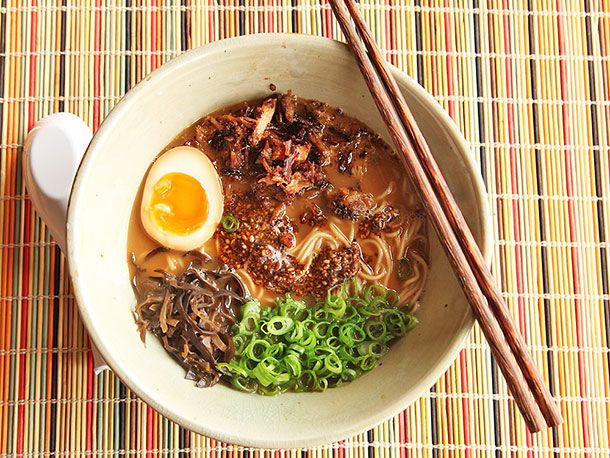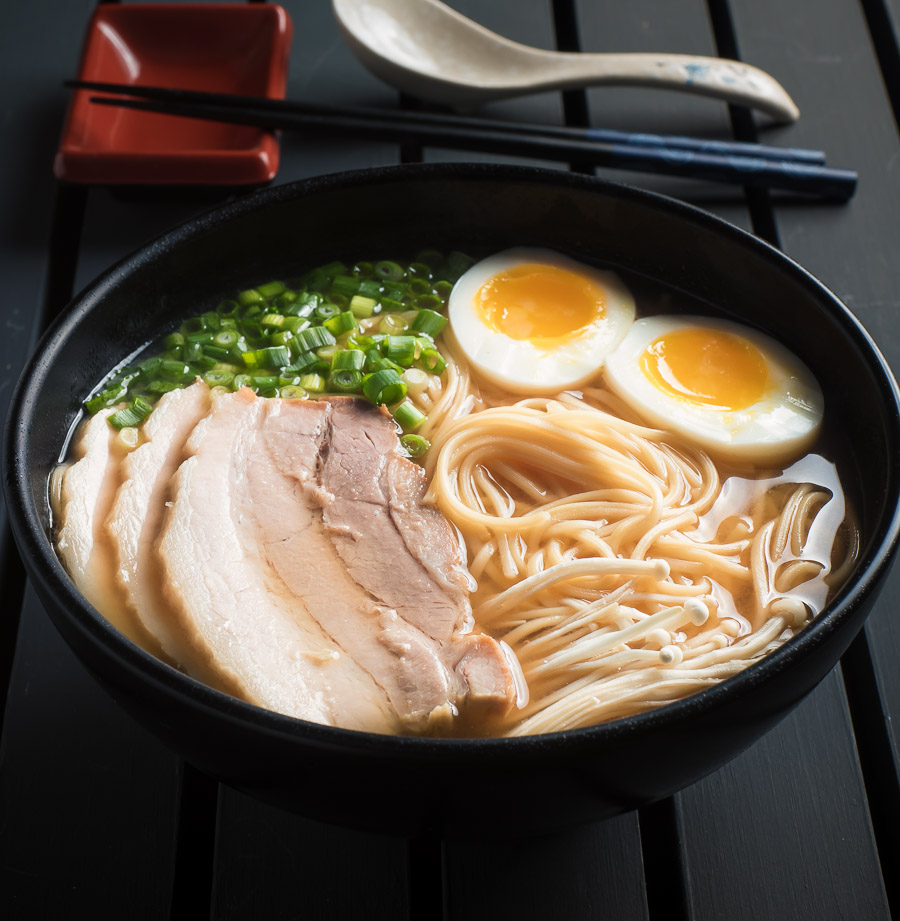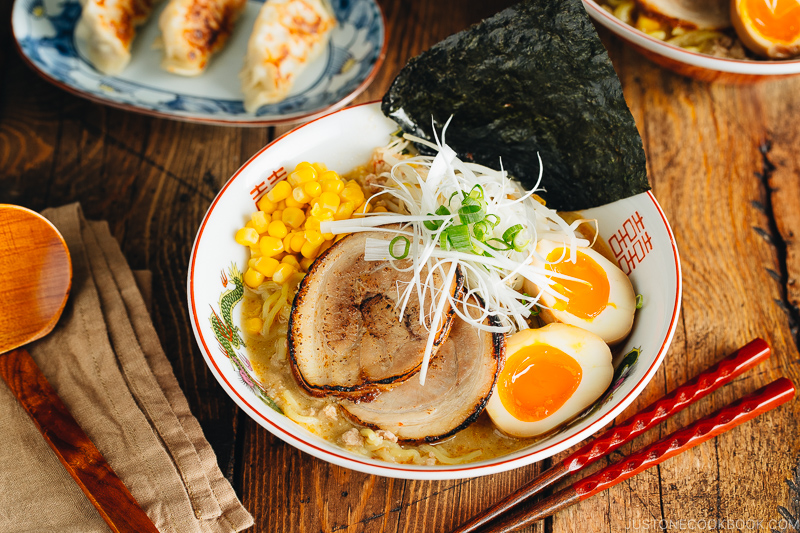Japanese Roast Pork Ramen is a delectable and satisfying dish that showcases the harmonious blend of roasted pork, flavorful broth, and perfectly cooked noodles. This mouthwatering recipe combines the rich and tender qualities of roasted pork with the comforting warmth of a hearty ramen bowl.
Originating from Japan, where ramen is considered a culinary art form, Japanese Roast Pork Ramen exemplifies the attention to detail and balance of flavors that are characteristic of Japanese cuisine. It is a dish that takes time and care to prepare, but the end result is a bowl of ramen that is deeply satisfying and worth the effort.

Japanese Roast Pork Ramen
Ingredients
Equipment
Method
- Add all the ingredients of the sauce i.e. miso paste, soy sauce, mirin paste and Japanese fresh herbs into a large pan.
- Add the roasted pork meat, shiso leaves, chopped tomatoes and the rest of the ingredients into the mixture.
- Cook the dish for ten minutes.
- Add the ramen into the mixture once the sauce is ready.
- Mix the ramen well.
- Cook the dish for five minutes.
- Add the shredded nori sheets into the dish.
- Your dish is ready to be served.
Video
Notes
Some frequently asked questions (FAQs) about Japanese Roast Pork Ramen:
1. What type of pork is best for roast pork ramen?
– Cuts of pork that work well for roast pork ramen include pork belly and pork shoulder. Look for cuts that are well-marbled with fat, as it adds flavor and tenderness to the meat.
2. Can I use pre-made broth for the ramen?
– While pre-made broth can be convenient, making your own broth from scratch allows for more control over the flavors. However, if you’re short on time, you can enhance store-bought broth by adding aromatics and simmering it with pork bones or chicken parts to boost the flavor.
3. Can I make the roasted pork in advance?
– Yes, you can make the roasted pork in advance. Once it is cooked, allow it to cool, then store it in an airtight container in the refrigerator. When ready to serve, gently reheat the pork slices in a low oven or in a pan on the stovetop.
4. Can I use other types of noodles for the ramen?
– Traditional ramen noodles are commonly used for Japanese Roast Pork Ramen. However, if you can’t find them, you can substitute with other types of noodles like wheat noodles or even spaghetti as a last resort. Adjust the cooking time according to the package instructions.

5. Can I freeze leftover broth or roasted pork?
– Yes, both the broth and roasted pork can be frozen. Allow them to cool completely before transferring them to freezer-safe containers or bags. Make sure to label and date them. When you’re ready to use them, thaw them in the refrigerator overnight and reheat before serving.
6. Can I customize the toppings and garnishes?
– Absolutely! Toppings and garnishes are a great way to personalize your ramen. Feel free to add or substitute toppings based on your preferences. Popular options include soft-boiled eggs, sliced scallions, nori seaweed, bamboo shoots, bean sprouts, and sesame seeds.
7. Is it possible to make the dish vegetarian or vegan?
– Yes, you can modify the recipe to suit vegetarian or vegan diets. For the broth, use vegetable stock or a combination of miso paste and vegetable broth. Substitute the pork with roasted tofu, mushrooms, or seitan for a meat-free option. Adjust the seasonings accordingly to achieve the desired flavors.
Remember, these answers are general guidelines, and you can adapt the recipe to suit your taste and dietary needs. Feel free to experiment and make the dish your own.
Some cooking tips to help you when preparing Japanese Roast Pork Ramen:
1. Choose the Right Cut of Pork: Opt for cuts of pork that are well-marbled with fat, such as pork belly or pork shoulder. The marbling will contribute to the tenderness and flavor of the roasted pork. If possible, select a thicker piece of pork to ensure it remains juicy after roasting.
2. Marinate for Maximum Flavor: Take the time to marinate the pork before roasting. Prepare a marinade using a combination of soy sauce, mirin, sake, ginger, garlic, and other desired seasonings. Let the pork marinate for several hours or overnight in the refrigerator. This will infuse the meat with a depth of flavor that will enhance the overall taste of the dish.
3. Roast Slow and Low: Roasting the pork at a low temperature for an extended period allows the fat to render and the meat to become tender. Preheat the oven to a moderate temperature, around 325°F (163°C), and roast the pork for a longer duration, ensuring it cooks evenly and becomes deliciously caramelized on the outside.
4. Baste for Moisture and Flavor: While roasting, baste the pork occasionally with the marinade or its juices. Basting helps to keep the meat moist and imparts additional flavors. It also helps to create a flavorful glaze on the surface of the pork.

5. Rest Before Slicing: Once the pork is done roasting, allow it to rest for a few minutes before slicing. This allows the juices to redistribute throughout the meat, resulting in more succulent and tender slices. Tent the pork loosely with foil to retain the heat and maintain its juiciness.
6. Skim Fat from Broth: If using a homemade broth for the ramen, skim any excess fat from the surface of the broth before serving. This will help to reduce the greasiness and ensure a cleaner and more enjoyable eating experience.
7. Cook Noodles Al Dente: Pay attention to the cooking time and instructions for the ramen noodles. Cook them until they are al dente, which means they should have a slight bite to them. Overcooked noodles can become mushy and affect the overall texture of the dish. Taste-test the noodles a minute or two before the recommended cooking time to ensure they are cooked to your preference.
8. Serve Immediately: Assemble the ramen bowls and serve them immediately after adding the noodles, broth, and roasted pork. Ramen is best enjoyed when it is piping hot. This ensures that the flavors meld together, the noodles remain at their optimal texture, and the pork is still warm and tender.
By following these cooking tips, you’ll be able to create a flavorful and satisfying bowl of Japanese Roast Pork Ramen. Enjoy the process of slow-roasting the pork and bringing all the components together to create a memorable and delicious meal.
Serving Suggestions
When serving Japanese Roast Pork Ramen, here are some suggestions to enhance the presentation and flavor of the dish:
1. Toppings Galore: Arrange a variety of toppings in separate bowls or plates for people to customize their ramen. Some popular options include thinly sliced scallions, bean sprouts, shredded cabbage, corn kernels, nori seaweed strips, and toasted sesame seeds. This allows everyone to add their preferred toppings and create a personalized bowl of ramen.
2. Soft-Boiled Eggs: Soft-boiled eggs are a classic and delicious addition to ramen. Slice the eggs in half and place them on top of the noodles. The creamy yolk adds richness to the dish.
3. Drizzle of Chili Oil: If you enjoy some heat, provide a small bottle of chili oil or chili paste on the table. This allows individuals to add a desired amount of spiciness to their ramen according to their taste preferences.
4. Side of Pickled Vegetables: Serve a side of pickled vegetables, such as pickled ginger, radish, or cucumbers. These tangy and refreshing accompaniments complement the rich flavors of the ramen and add a contrasting texture.

5. Add a Sprinkle of Furikake: Furikake is a Japanese seasoning blend made with dried seaweed, sesame seeds, bonito flakes, and other flavorful ingredients. Sprinkle a little furikake over the ramen to add extra umami and crunch.
6. Serve with a Side of Gyoza: For a complete Japanese meal experience, consider serving gyoza (Japanese dumplings) as a side dish. The combination of the flavorful ramen and the savory dumplings creates a satisfying meal.
7. Miso Soup on the Side: Accompany the ramen with a small bowl of miso soup. Miso soup provides additional warmth and complements the flavors of the ramen.
8. Pair with Green Tea: Japanese green tea, such as sencha or matcha, is a popular beverage choice to accompany ramen. The slightly bitter and refreshing taste of green tea helps cleanse the palate between bites.
Remember to provide chopsticks, spoons, and napkins for easy enjoyment. With these serving suggestions, you can create a visually appealing and well-rounded dining experience, allowing everyone to customize their ramen and enjoy the flavors to the fullest.








